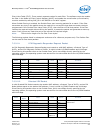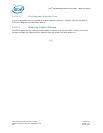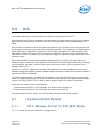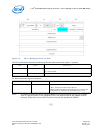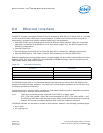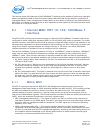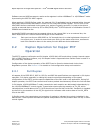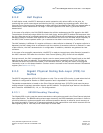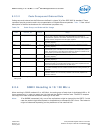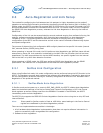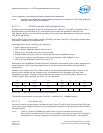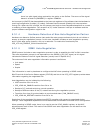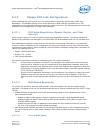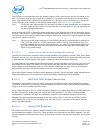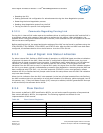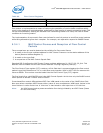
SGMII Encoding in 10/100 Mb/s — Intel
®
82575EB Gigabit Ethernet Controller
324632-003 Intel
®
82575EB Gigabit Ethernet Controller
Revision: 2.1 Software Developer’s Manual and EEPROM Guide
January 2011 245
9.2.3.2 Code Groups and Ordered Sets
Code group and ordered set definitions are defined in clause 36 of the IEEE 802.3z standard. These
represent special symbols used in the encapsulation of Gigabit Ethernet packets. Table 79 lists a brief
description of defined ordered sets for informational purposes only.
Table 79. Code Group and Ordered Set Usage
9.2.4 SGMII Encoding in 10/100 Mb/s
When working in SGMII mode at 10 or 100 Mb/s, the code group of each byte is duplicated 100 or 10
times respectively, in order to match the link rate and the SerDes interface rate. The 82575 samples
one copy from each received set before sending it to the MAC.
Note: If an RXERR is asserted (1b), one of the replications might be ignored by the 82575. In this
case the packet might be accepted or dropped due to subsequent CRC errors. This behavior
might be observed depending on the placement of the external PHY.
Code Ordered_Set
# of Code
Groups
Usage
/C/ Configuration 4 General reference to configuration ordered sets, either
/C1/ or /C2/, which is used during Auto Negotiation to advertise &
negotiate link operation information between link partners. Last two code
groups contain config base and next page registers.
/C1/ Configuration 1 4 See /C/. Differs from /C2/ in second code group for maintaining proper
signaling disparity.
/C2/ Configuration 2 4 See /C/. Differs from /C1/ in second code group for maintaining proper
signaling disparity.
/I/ IDLE 2 General reference to IDLE ordered sets. IDLE characters are continually
transmitted by the end stations and are replaced by encapsulated packet
data. The transitions in the IDLE stream allow the SerDes to maintain clock
and symbol synchronization between to link partners.
/I1/ IDLE 1 2 See /I/. Differs from /I2/ in second code group for maintaining proper
signaling disparity.
1
1. The concept of running disparity is defined in the standard. In summary, this refers to the 1-0 and 0-1 transitions within 8B10B
code groups
/I2/ IDLE 2 2 See /I/. Differs from /I1/ in second code group for maintaining proper
signaling disparity
a
.
/S/ Start_of_Packet 1 The SPD (start_of_packet delimiter) ordered set is used to indicate the
starting boundary of a packet transmission. This symbol replaces the first
byte of the preamble received from the MAC layer.
/T/ End_of_Packet 1 The EPD (end_of_packet delimiter) is comprised of three ordered sets. The
/T/ symbol is always the first of these and indicates the ending boundary of
a packet.
/V/ Error_Propagation 1 The /V/ ordered set is used by the PCS to indicate error propagation
between stations. This is normally intended to be used by repeaters to
indicate collisions.



